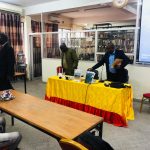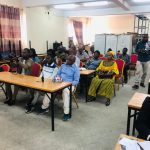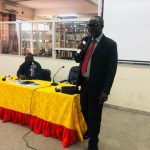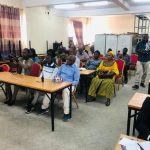Essai de la combinaison des microdoses d’engrais minéraux avec le super Gro sur la productivité de la nouvelle variété biofortifiée du maïs UPN1 dans un sol sableux de Kinshasa.

David Nsimba Nsiku*, Amand Mbuya Kankolongo (*, **), Christophe Asanzi Mbeyame (*, **), Richard Risasi Etutu (*, ***), Antoine Mumba Djamba(*, **) et Jean-Claude Lukombo Lukeba (*, **).
*Département de Phytotechnie, Faculté des Sciences Agronomiques, Université Pédagogique Nationale (RD Congo).
**Institut National pour l’Etude et la Recherche Agronomique (INERA)
***Institut Supérieur des Sciences de la Santé de la Croix-Rouge (ISSS/CR).
https://doi.org/10.59937/FMTD2916
Résumé
L’objectif de cette étude était de trouver une modalité de fertilisation qui, associée aux doses modestes d’engrais minéraux, soit capable d’améliorer la productivité et réduire les coûts de production du maïs dans les sols pauvres de Kinshasa. Cinq traitements ont été testés sur la variété UPN1, dans un essai conduit en saison B 2020 au CEPROSEM suivant un dispositif en bloc complet randomisé avec 4 répétitions : T0= témoin (sans engrais); T1= 200kg NPK 17-17-17 + 100kg Urée/ha; T2= 200kg NPK 17-17-17/ha + super Gro (0,1%) ; T3= 100 kg NPK 17-17-17/ha + super Gro (0,2%) et T4=100 kg NPK 17-17-17+ 50kg Urée/ha + super Gro (0,1%). Excepté le poids de mille grains qui n’a pas été influencé, les résultats obtenus après analyse de variance ont montré des différences hautement significatives pour les deux premiers paramètres de croissance (HP et DC) et significatives pour le reste. Du point de vue agronomique (productivité physique), la fertilisation à base de 200kg de NPK/ha et Super Gro (0,1%) a donné une bonne croissance des plants et un bon rendement en maïs grain (5,12 t/ha). L’essai devrait être reconduit en Saison A et dans d’autres environnements en vue d’une vulgarisation définitive de cette technologie aux maïsiculteurs congolais.
Mots -clés : Maïs, microdose, engrais, biofertilisants, rendement.
Abstract
The objective of this study was to find a fertilization modality that, combined with modest doses of mineral fertilizer, would be able to improve productivity and reduce production costs of maize in the poor soils of Kinshasa. Five treatments were tested on the variety UPN1, in a trial conducted in season B 2020 at CEPROSEM in a randomized complete block design with four replications: T0= control (no fertilizer); T1= 200kg NPK 17-17-17 + 100kg Urea/ha; T2= 200kg NPK 17-17-17/ha + super Gro (0.1%); T3= 100kg NPK 17-17-17/ha + super Gro (0.2%) and T4=100kg NPK 17-17-17+ 50kg Urea/ha + super Gro (0.1%). Except for the thousand kernel weight which was not influenced, the results obtained after analysis of variance showed highly significant differences for the first two growth parameters (HP and DC) and significant for the rest. From the agronomic point of view (physical productivity), the fertilization based on 200kg of NPK/ha and Super Gro (0.1%) gave a good growth of
the plants and a good yield in corn grain (5.12 t/ha). The trial should be repeated in Season A and in other environments for a definitive extension of this technology to Congolese maize farmers.
Keywords: Maize, microdose, fertilizer, biofertilizers, yield.






















































